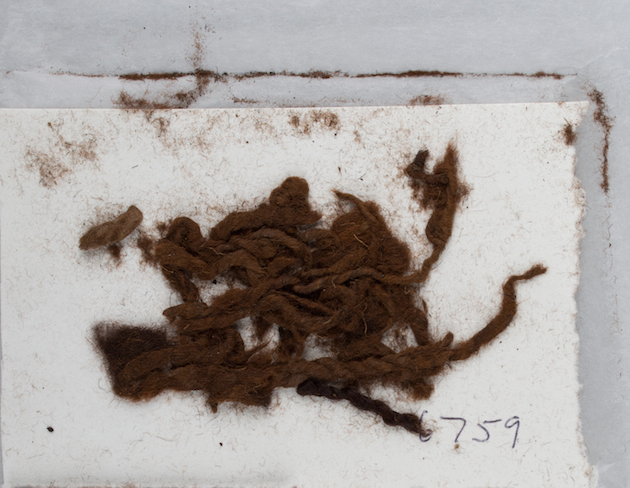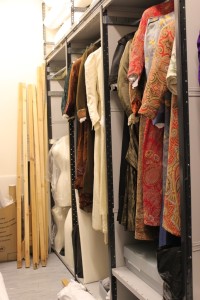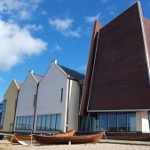
by Geraldine Sim, 2nd year student MPhil Textile Conservation.
About the project
For my final year dissertation of the MPhil Textile Conservation course at the University of Glasgow, I am working with Dr Carol Christiansen from the Shetland Museum and Archives on the re-housing of a collection of archaeological textile fragments from the island of Papa Stour.
This collection of over 200 individual knitted and woven textiles, cords and fibre samples was excavated in the late 1970s. Following their excavation, they were catalogued and studied at Glasgow University Archaeological Research Division (GUARD, now GUARD Archaeology Ltd). While a few fragments received conservation treatment for publication purposes, most of the collection remains in its original find bags and are displaying signs of deterioration such as fibre loss and distortion.
The opportunity to research the collection for my dissertation arose when it was recognized that improved storage mounts may be advantageous as they are passive and non-interventive while encouraging careful handling and improving access in the long term.
About the visit
The fragments themselves were moved to the Centre of Textile Conservation where I was able to familiarize myself with the collection by undertaking condition surveys with photo documentation of all fragments. However, in order to fully understand where they have come from and the conditions they will return to following this project, a visit to Shetland Museum and Archives stores was made.
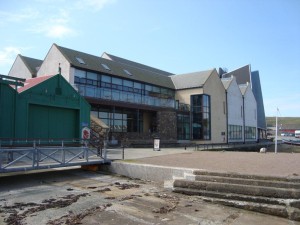 Based in the city of Lerwick in Shetland, the Shetland Museum and Archives was opened on the 31st of May 2007 and serves as a multifunction visitor attraction forming a gateway to Shetland’s heritage and culture. It’s collection focuses on 8 different areas; these include natural history, archaeology, folklife, social history, industry, textiles, fisheries and maritime. The textiles collection is a Recognised Collection of National Significance in Scotland due to its quality and iconic importance.
Based in the city of Lerwick in Shetland, the Shetland Museum and Archives was opened on the 31st of May 2007 and serves as a multifunction visitor attraction forming a gateway to Shetland’s heritage and culture. It’s collection focuses on 8 different areas; these include natural history, archaeology, folklife, social history, industry, textiles, fisheries and maritime. The textiles collection is a Recognised Collection of National Significance in Scotland due to its quality and iconic importance.
The museum’s collection is also stored, at an off-site location about 3km away on the upper level of the 2-storey building, the archaeological collection is stored within the textile store. The store is climate controlled with control of relative humidity (RH) aiding in the control of the temperatures within.
Though both hanging and rolled storage are available within the large textile store, the main infrastructure within this store is metal racking on which the museum’s textile and garment collections rest within their archival boxes. It is on these shelves that the archaeological fragments were stored within 4 shallow brown boxes.
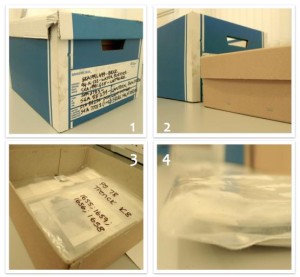
What now?
My visit to Shetland was a wonderful experience both personally and in terms of my research. The trip itself was a great adventure – with a reclining seat ‘pod’ on the overnight ferry to Lerwick being an experience in itself! Seeing the type of landscape in which the fragments were made, used and excavated really helped me to appreciate their uniqueness. Being able to visit Shetland Museum and Archives has allowed me to place the archaeological fragments within a wider context of the collection as a whole as well as in understanding the physical environment to which they will return following this study.
Most importantly, having been able to meet with and discuss specific concerns with textile curator Dr Christiansen will now allow me to make more targeted recommendations in their re-housing; one reflecting both the object’s role, institutional resources while promoting best practices in the care and conservation of archaeological textiles.
I am grateful to the June Baker Trust for their generous grant which enabled me to make the visit to Shetland and to Dr Christiansen for giving me so much of her time and making the visit so informative and enjoyable.


